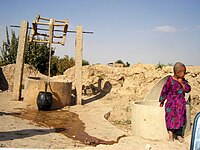
Photo from wikipedia
Abstract The military dictatorship that took power in Argentina from 1976 to 1983, brought enforced disappearance and death to thousands of people in the country. “Pozo de Vargas” is a… Click to show full abstract
Abstract The military dictatorship that took power in Argentina from 1976 to 1983, brought enforced disappearance and death to thousands of people in the country. “Pozo de Vargas” is a 3.5 m wide and 60 m deep dry water well used as a massive clandestine burial site in Tucuman, Argentina. The site contained commingled remains as well as partially articulated body parts. Since 2011, EAAF Forensic Genetics Laboratory (LGF-EAAF) has been processing post mortem (PM) samples exhumed from the well to achieve the intra-skeletal re-association and the identification of the bodies or body parts. 981 skeletal remains, with different states of preservation, were analyzed for STR typing using commercial available kits. Different bone elements were exhumed for intra-skeletal re-associations (PM-PM genetic comparisons): teeth, femur and tibia represented more than 65% of sampling and almost all of them were successfully re-associated; spongy bones as scapula, vertebrae and clavicles yielded worse results, although almost 80% of them were also re-associated. 871 skeletal remains (89%) were successfully typed for autosomal STR markers and re-associated into 147 unique STR profiles meaning that at least 147 different individuals were thrown into the water well. After re-association, unique STR profiles obtained from the skeletal remains were compared to ante mortem (AM) family reference database in order to identify victims (AM-PM genetic comparisons), being possible to restore 113 victims to their families. Another challenge of this identification project was the presence of biologically related victims inside the well.
Journal Title: Forensic Science International: Genetics Supplement Series
Year Published: 2019
Link to full text (if available)
Share on Social Media: Sign Up to like & get
recommendations!